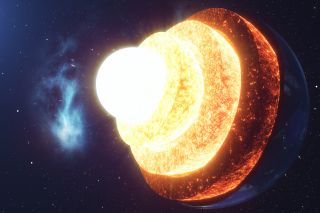List members , now this mystery seems to mock the mainstream theory for internal structure of planets - it really takes the cake :))
Earth's core is growing 'lopsided' and scientists don't know why
By Brandon Specktor - Senior Writer 1 day ago
The core is losing heat faster under Indonesia than it is under Brazil, and that's messing with the seismic waves passing through it.

Earth's solid inner core may be growing in a 'lopsided' pattern, new research suggests. (Image credit: Shutterstock)
There's a mystery brewing at the center of the Earth.
Scientists can only see it when they study the seismic waves (subterranean tremors generated by earthquakes) passing through the planet's solid iron inner core. For some reason, waves move through the core significantly faster when they're traveling between the north and south poles than when they're traveling across the equator.
Researchers have known about this discrepancy — known as seismic anisotropy — for decades, but have been unable to come up with an explanation that's consistent with the available data. Now, using computer simulations of the core's growth over the last billion years, a new study in the June 3 issue of Nature Geoscience offers a solution that finally seems to fit: Every year, little by little, Earth's inner core is growing in a "lopsided" pattern, with new iron crystals forming faster on the east side of the core than on the west side.
"The movement of liquid iron in the outer core carries heat away from the inner core, causing it to freeze," lead study author Daniel Frost, a seismologist at the University of California, Berkeley, told Live Science. "So this means the outer core has been taking more heat from the east side [under Indonesia] than the west [under Brazil]."
To visualize this lopsided growth in the core, imagine a tree trunk with growth rings radiating out from a central point, Frost said — but "the center of the rings is offset from the center of the tree," so that rings are spaced further apart on the east side of the tree and closer together on the west side.
A cross section of Earth's inner core might look similar to that. However, this asymmetric growth doesn't mean that the inner core itself is misshapen or at risk of becoming imbalanced, the researchers said.
The team's model proposes that Earth’s inner core grows faster on its east side (left) than on its west. Gravity equalizes the asymmetric growth by pushing iron crystals toward the north and south poles (arrows). This tends to align the long axis of iron crystals along the planet’s rotation axis (dashed line), explaining the different travel times for seismic waves through the inner core. (Image credit: Marine Lasbleis)
On average, the inner core's radius grows evenly by about 0.04 inches (1 millimeter) every year. Gravity corrects for the lopsided growth in the east by pushing new crystals toward the west. There, the crystals clump into lattice structures that stretch along the core's north-south axis. These crystal structures, aligned parallel with Earth's poles, are seismic superhighways that enable earthquake waves to travel more quickly in that direction, according to the team's models.
Unpacking the snowball
What's causing this imbalance in the inner core, anyway? That's hard to say without looking at all the other layers of our planet, Frost said.
"Every layer in the Earth is controlled by what's above it, and influences what's below it," he said. "The inner core is slowly freezing out of the liquid outer core, like a snowball adding more layers. The outer core is then cooled by the mantle above it — so to ask the question of why the inner core is growing faster on one side than the other might be asking the question of why is one side of the mantle cooler than the other?"
Tectonic plates could be partially to blame, Frost said. As cold tectonic plates dive deep below the Earth's surface at subduction zones (places where one plate sinks below another), they cool the mantle below. However, whether mantle cooling could impact the inner core is still a subject of debate, Frost said.
Equally puzzling is whether or not the lopsided cooling in the core could be affecting Earth's magnetic field. The modern-day magnetic field is powered by the movement of liquid iron in the outer core; this liquid's movement is powered in turn by heat lost from the inner core. If the inner core is losing more heat in the east than the west, then the outer core will move more in the east too, Frost said.
"The question is, does this change the strength of the magnetic field?" he added.
Questions this big are beyond the scope of the team's new paper, but Frost said he has begun work on new research with a team of geomagnetists to investigate some possibilities.
Originally published on Live Science.
Regards

